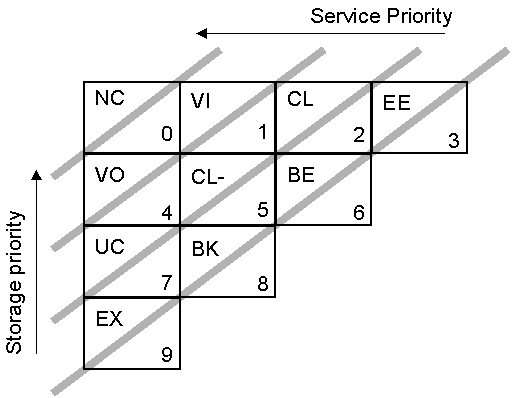Simulation help: Queue Settings
There are two sheets with Queue settings. This is to let you specify two different queues, and let them serve exactly the same traffic. After that, they can easily be compared on their performance. Beside the fact that one sheet is called "First Queue" and the other "Second Queue" there is no real difference between the queues. If they were swapped, the results would be the same.
There are six possible choices for a queue. They are listed below, together with links to the explanations of their parameters and links to more detailed explanations of their working.
- FIFO Queueing
The simplest form of queuing. Perfect reference.
- LDoLL Queuing
A simple priority system with two different priorities
- LDoLL with limited LD buffer
A slightly modified LDoLL Queue. The modifications improve the delay characteristics of Low Delay traffic.
- LDoLL Extended
An queue based on LDoLL but with a far greater number of priorities.
- Voice First
A very simple mechanism with limited possibilities, but attractive capabilities
- FIFO-Tail drop
A normal FIFO queue that uses tail drop instead of head drop.
FIFO Queuing
FIFO (First In First Out) is probably the simplest and the oldest queuing mechanism available. It will probably stay wildly used in the future for attractions like the Efteling in Kaatsheuvel or at your local supermarket.
There is only one parameter to set: the queue size. In the applet this is specified in bytes.
Back to the top
LDoLL Queuing
LDoLL provides two different treatments for packets. One is concentrated on providing the lowest possible delay; the other is concentrated on providing the lowest possible loss. Serving the low delay packets first fulfills this objective, and only serving the low loss packets when there are no low delay packets left. However, when too much low loss packets are in the buffer waiting, their loss probability increases. Therefor, a threshold value is used. When the number of Low Delay bytes in the buffer exceeds the threshold, Low Loss packets are serviced first.
LDoLL has three parameters: The queue's size must be specified in bytes. The second parameter defines when an incoming packet is specified as Low Loss or low delay. It is the lowest class code used for Low Delay. Every packet with a class code (traffic type) equal or higher than this number is treated as Low Delay. Packets with lower numbers are treated as Low Loss
The last parameter is the threshold used to determine when Low Loss traffic receives service.
The traffic types are numbered as follows:
|
Class |
Code |
|
NC, Network Control |
0 |
|
VI, Video |
1 |
|
CL, Controlled Load |
2 |
|
EE , Excellent Effort |
3 |
|
VO, Voice |
4 |
|
CL-, Less Controlled Load |
5 |
|
BE, Best Effort |
6 |
|
UC, Uncontrolled Load |
7 |
|
BK, Background |
8 |
|
XS, Excess |
9 |
LDoLL also has some extensions. LDoLL with limited LD buffer limits the number of bytes that may be used by LD traffic. This implies that LD packets will have a higher loss probability than they used to have. It will also decrease their delay. LDoLL with limited LD delay drops Low Delay packets when their delay would be above a preset threshold. This also leads, of course, to a higher loss probability.
Back to the top
LDoLL Extended
LDoLL Extended is an extension of the LDoLL mechanism to allow more different priorities.
This queue organizes the different classes in four groups as shown in the picture below.

The groups indicated with the diagonal gray bars each have a time-slice assigned to them. You must specify these time-slices in bytes.
Within each group, LDoLL is used to determine which packet receives service. You can specify these thresholds on two levels. One is the threshold that determines when EE, CL or VI receives service. The second determines when BE or CL- receives service. XS is treated in a different way: It will only receive service when neither EE, BE nor BK has any packet waiting.
Back to the top
Voice First Queuing
Voice First Queuing has just one important parameter: Which traffic type receives absolute service priority i.e. will be serviced first when the packet currently receiving service is completed.
All other traffic types receive a time slice of a certain length. All types will receive the same slice.
Back to the top
FIFO Tail Drop
The same as FIFO-Queuing, with one difference: Instead of dropping packets at the front of the queue, packets are dropped at the back of the queue. This will result in a different delay.
Back to the top
Copyright © 2000 Philips Business Communications, Hilversum, The Netherlands.
See legal statement for details
